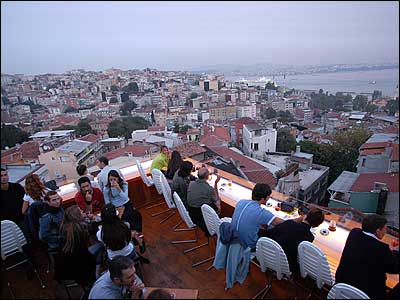The Shopper

Alexia Kondylis, an apparel-design grad turned interior designer, is always shopping. “There’s not a day that goes by when I’m not looking for something,” she says. Despite socialite good looks and acquaintances like Zac Posen, Kondylis prefers the ardent pursuit of the “weird and crafty” to complacent, label-driven buying (not that she’s against a nice label now and then). Fleeing fashion mimicry in New York, she’s visited the boutiques, antique dealers, flea markets, and street vendors of Paris, Milan, London, and Rome—not to mention Athens, Hamburg, and Salzburg. “As a clothing collector, I’m really into the artistry of things, and I see a lot more of that elsewhere.”
The Trip

By all rights, Istanbul ought tobe a must-stop on any self-respecting international shopper’s itinerary. The Grand Bazaar has been in continuous operation since the fifteenth century, after all, and the city’s handicraft industries (fabrics, embroidery, furniture) are still going strong a couple of millennia after their emergence. Istanbul is uniquely proud of its designers and craftsmen, which means it’s kept its uniquely Occidental-Oriental character and largely resisted the global luxury-brand juggernaut that’s homogenized so many other shopping spots. But for decades, Istanbul wasn’t a shopper’s destination with any real appeal—unless you were in the market for a carpet or a nice carved Byzantine chest. A newly flourishing fashion scene, though, is changing that. Jean Paul Gaultier, Oscar de la Renta, and Kenzo designer Antonio Marras have all come recently to soak up inspiration from Istanbul’s open markets and chaotic backstreets. Eccentric British style muse and cool-seeker Isabella Blow strolled the trendy Tünel district last summer. In the past two years, the city has welcomed its first dedicated fashion PR company and a slick new style magazine called 34. Homegrown designers like Arzu Kaprol and Hakan Yildirim have opened their own stores, while others like Atil Kutoglu and Bahar Korçan are even showing in New York. Turkish-born Mavi Jeans are up there with the biggest names in pricey denim, and there’s even talk of an Istanbul-based Turkish Fashion Week.
What’s fueling the new wave of interest is an old-meets-new, East-meets-West vibe. A young woman in loose palazzo pants made from locally woven gauzy cheesecloth and a tight T-shirt, or a bikini-clad sun-worshipper protecting her head with a modern take on a turban, or a miniature Koran hanging around the neck of a Versace-clad music-TV presenter—that’s Istanbul style. And you won’t find it in New York, or anywhere else.
Unlike Paris’s Rue Saint Honoré or Milan’s Via Montenapoleone, Istanbul has no central chic street—any profitable trip through the city’s shops requires a trawl around several districts. Startwith the wealthy, relaxing, user-friendly Nisantasi quarter. Here you’ll find Kaprol’s basement boutique, on Abdi Ipekçi Caddesi, the closest thing to a Turkish Madison Avenue. Kaprol captures the Istanbul look in pieces like a cream chiffon gown embroidered in gold with Ottoman-style calligraphy, or in a buttery-soft, lightweight leather jacket whose sumptuous silk lining has a tulip print drawn from a Turkish ceramics motif. Accessorize her pieces across the street at the tiny jewelry outlet of Nazan Pak and Ela Cindoruk, whose slick, organic silver or platinum rings, necklaces, and earrings are all about the old-new balance. Don’t miss cut-and-fold enthusiast Hakan Yildirim’s office showroom and ready-to-wear outlet—his simple, lightweight color-block dresses are beloved by singers and actresses who wear them to premieres, concerts, and nightclubs all summer long; a younger clientele goes for sexier pleated miniskirts. The Istanbul love of fabrics comes out in full force at Gonul Paksoy’s eponymous shop; a chemist by training, she dips floaty silks, linen, and cotton in the dyes she cooks up on her stove, then fashions them into diaphanous garments inspired by Sufi whirling dervishes.
Hipsters and others who think Nisantasi’s charms are too obvious prefer Beyoglu, the once-prosperous Ottoman district now back in favor with smart young things. Start at the Mavi Jeans flagship store on Istiklâl Avenue, where you can also buy CDs of new Turkish music like the techno-Sufi sounds of Mercan Dede and the winning combination of the jazzy Orient Expressions and Kurdish singer Aynur. Then delve into the backstreets. Turn down the hill from the imposing gates of Galatasaray Lisesi into Çukurcuma, an antiques district currently undergoing an upmarket makeover. The focal point here is the winding Faik Pasa Yokusu, which houses Erkal Aksoy’s A la Turca, a house-cum-showroom of decorative objects (don’t miss the stacks of antique ceramics in the basement). Next door is Emine Turan’s design gallery, Accenturc, a light-filled two-floor space filled with sculpture, lighting, furniture, and painting, as well as an ever-changing selection of jewelry by local designers, including the owner. Across the road is furniture and interior designer Hakan Ezer, whose handsome and sophisticated leather work in particular has gained fans among the Ralph Lauren set.
But the coolest part of Beyoglu today is the boho Tünel end, an area around a nineteenth-century funicular leading down to the Bosphorus’s shores. Tucked in with Tünel’s antique bookstores, musical-instrument shops, and cafés is Umit Unal’s airy, whitewashed showroom, where he takes inspiration from unlikely sources (Chinese peasants, tribes of Gypsies) and turns that into avant-garde clothes—made, of course, from Turkish fabric.
Still standing? Take the trip across the Golden Horn inlet to the Old City and the labyrinthine Grand Bazaar. It’s still seen by many as a pricey warren populated by ripoff artists—and in parts, it is. But there are treasures, too: hand-painted fabrics in the tiny Sivasli Yazmaci boutique on the side alley Yaglikcilar Caddesi; herbal soaps and silky goat-hair Sivas blankets at the beautiful bath shop Hamam; and exquisite brass, copper, or bronze objects at L’Orient. Dolce & Gabbana buyers have shopped at Egin Tekstil, where Dr. Suleyman Ertas makes most of the fabrics himself; bring home a singularly beautiful curtain, tablecloth, or set of sheets.
The city’s sprawl, not to mention its abominable traffic, takes a toll, so downtime is a requirement—and this is the city that invented the Turkish bath. Try Dreamlands, an elegant spa in the Bebek district on the Bosphorus, whose therapists have treated no less a fashion body than Naomi Campbell’s. Of course, café-sitting is another way to unwind; the pretty-people-watching factor is especially high at Assk Cafe in Kuruçesme, where soccer players, pop singers, and models stop in to snack on the refreshing combination of goat cheese and watermelon, or sticky-sweet tahin pekmez smeared on homemade brown bread.
If you can’t get enough of the fashion crowd, have dinner at Helvetia Lokanta in Tünel, where Hussein Chalayan and Umit Unal go for plates of typically Turkish food like menemen (eggs cooked with tomatoes), olives, sweet jams, and local fruits and cheeses. Mingle with the minimally clad, spray-on-jean brigade of music aficionados in the hottest dance club, Babylon. Or sip a cocktail in new, minimal-chic Istanbul 360. With its panoramic view of the city, it’s the perfect place to watch the old and the new blend.
The warmly minimalist Bentley Hotel (from $150; 90-212-291-7730) is popular with trendy Europeans. The Four Seasons Istanbul (from $340; 90-212-638-8200) is uniquely set in a former Ottoman prison and close to the Old City’s major sights. Dreamlands Spa (90-212-263-86-42); Assk Cafe (90-212-265-4734); Helvetia Lokanta (90-212-245-8780).